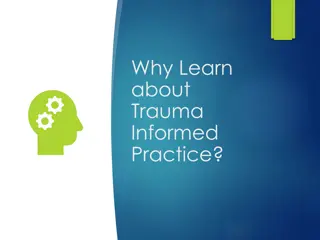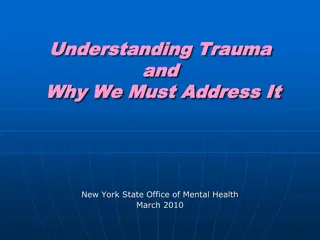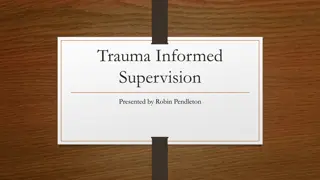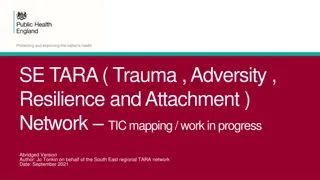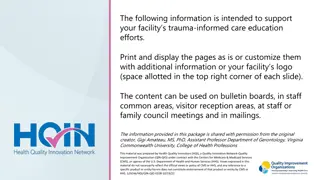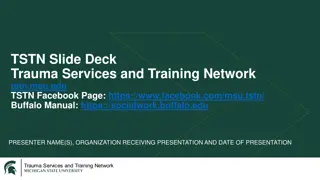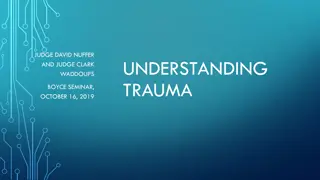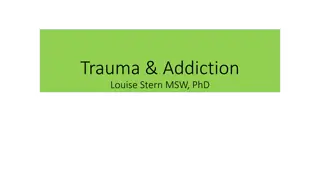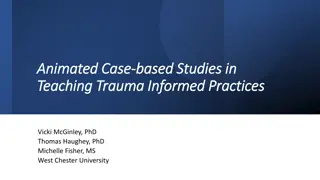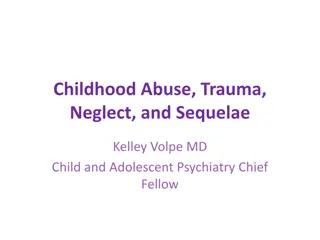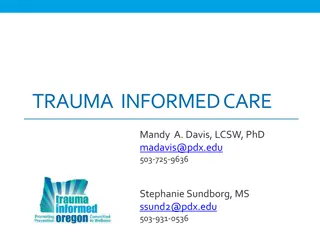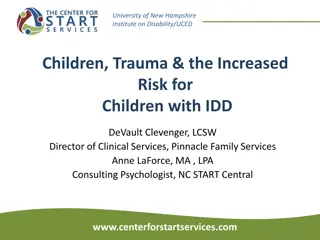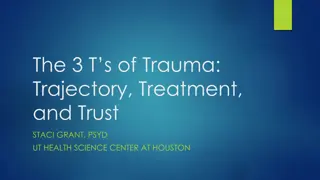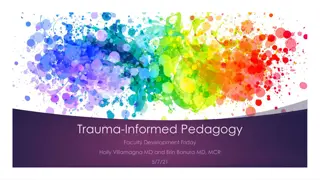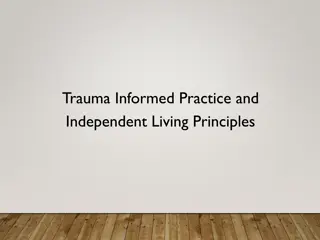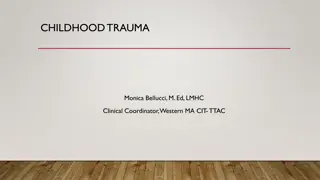Understanding and Managing Trauma Reminders in Training
Explore the nature of trauma reminders, learn to identify skills for navigating them, and understand the impact of trauma and grief in a non-therapeutic training setting. Take care of yourself during the educational session and develop awareness and skills to manage overwhelming reactions effectively.
Download Presentation

Please find below an Image/Link to download the presentation.
The content on the website is provided AS IS for your information and personal use only. It may not be sold, licensed, or shared on other websites without obtaining consent from the author. Download presentation by click this link. If you encounter any issues during the download, it is possible that the publisher has removed the file from their server.
E N D
Presentation Transcript
Managing Trauma Reminders
Training Considerations The objectives of this training are educational Content may bring up thoughts and feelings This is not intended to be a therapeutic environment or a space for sharing individual trauma stories or deeply personal information Take care of yourself Take a break for a drink/snack, restroom or any other reason. Be mindful of your feelings and what you need to be successful today
Objectives Define trauma and grief and the nature of trauma and grief responses Explore the nature of trauma reminders Identify skills for navigating trauma reminders
What is Trauma? The Three E's Event Event Effect Effect Experience Experience
Trauma, Grief and Traumatic Grief DEFINITIONS Trauma Traumatic Grief An event, series of events, or circumstances experienced by an individual as physically and emotionally harmful or life- threatening. The combined experience of trauma and grief that can prevent or interfere with the natural mourning process and have a lasting negative impact on well- being and functioning.
Trauma Responses Re-experiencing Avoidance Hyperarousal Changes in thoughts and Feelings
Trauma and Loss Reminders Places and people Events and situations Sensory (sounds, smells, tastes, colors) Emotions Time (time of day, day of week, specific dates) Secondary adversities and life changes
About Trauma Reminders Exposure to reminders can be a source of stress and activate a range of feelings. This does not always mean that you are being triggered or having a trauma response. Feeling reflective, sad and concerned are natural responses. Reactions can take time to resolve but they will typically within a reasonable time frame Noticing and sitting with your reactions can be helpful. We pause and reflect to develop personal awareness this is a part of healing. We need to develop and practice skills to manage any reactions that overwhelm us.
Principles of a Trauma-Informed Approach Safety Consideration of cultural, historical and gender issues Trustworthiness and Transparency Empowerment, Voice and Choice Peer Support Collaboration and Mutuality
Universal Precautions HOW DO I REDUCE THE POSSIBILITY OF TRIGGERING AND RE-TRAUMATIZING OTHERS? Reduce possibilities of triggering and re-traumatization Avoid frequent and recurring discussions of the trauma in settings not meant for that purpose. Give participants of meetings, classes, and projects notice of potentially triggering topics. Provide options and choice whenever possible. Use of professional self to establish and maintain safety in the interaction Communicate clearly. What are my expectations, and what should the other person expect? Be honest and empathic Maintain appropriate and consistent boundaries Understand trauma responses Fight, Flight, Freeze Understand that trigger and trauma reminders come in all forms - senses, feelings, thoughts, places, and occurrences Be open to recognizing that other people have different understanding and lack of understanding of trauma based on what languages and cultures they represent (The Institute on Trauma and Trauma-Informed Care, 2022)
Skills for Psychological Recovery Gathering Information and Prioritizing Assistance Problem Solving Skills Positive Activities Managing Reactions Helpful Thinking Social Connections
Gathering Information and Prioritizing Assistance Why? If someone comes to you following a traumatic event, this skill can help you evaluate their needs and assess how best to help them using referral or other skills in this model. How? F h l p by p q Assess if you are the best person to assist that person or if they need to be referred Make a plan for the best way to address their concerns by working with them to prioritize their needs (Berkowitz et al., 2010).
Problem Solving Skills Why? Traumatic events can lead to secondary adversities, life changes, and new challenges, which can lead to some feeling helpless, overwhelmed, or immobilized by these demands of life. How? H lp h p f h p bl ( ) b pl x p bl bl h . Prioritize problems in order of which needs to be addressed first. Set a realistic goal that addresses their desired outcome Brainstorm possible ways one could go about achieving that goal. Suggest ideas, if helpful Evaluate and choose the best solutions (NCTSN Core Curriculum on Childhood Trauma Task Force, 2012; Berkowitz et al., 2010).
Promoting Positive Activities Why? Trauma can disrupt normal routines that usually provide a sense of safety, control, and purpose. Planning and reengaging with positive activities can reestablish routines, improve mood, and restore a sense of control How? Identify a list of activities the person enjoys/used to enjoy Choose 1-3 activities to try this week Schedule those activities into your calendar h f f y l j y , h ppl h b , h f b f y scheduled activity (Berkowitz et al., 2010).
Managing Reactions Why? Trauma survivors may experience different post-traumatic symptoms from one another and can exhibit a wide range of reactions to trauma and loss (NCTSN). These symptoms may be exacerbated when a trauma reminder is present. Learning skills to help calm physical and emotional reactions can protect physical and mental health, relationships, and functioning. How? Remember different things work for different people Identify distressing reactions and trauma reminders for oneself Learn and guide others in breathing techniques, grounding exercises, movement tools, and writing down thoughts and feelings Get support from professionals (NCTSN Core Curriculum on Childhood Trauma Task Force, 2012; Berkowitz et al., 2010).
Helpful Thinking Why? After a traumatic event, people may struggle with distressing thoughts. Negative thought patterns can lead to more fear, anxiety, anger, guilt, sadness, and other negative feelings. How? Remember that helpful thinking does not always mean positive thinking. Challenge oneself or another to think of the statement differently F x pl , Ab l ly nothing ll y I h h h b h ll . (Berkowitz et al., 2010).
Healthy Social Connections Why? Following a traumatic experience, individuals may feel isolated or like a burden. Survivors with positive social support recover more easily. How? Facilitate or support ways for communities to connect in meaningful ways Explore ways to be a supportive and safe person for the communities to which you belong, work, or live Encourage others to connect with diverse support people (home, school, work, affinity groups, etc.) Encourage campus or community involvement (Berkowitz et al., 2010).
Resources to support SPR Skill Development Managing Trauma Reminders: Practice Guide Webpage recording, discussion guide, slide deck and Practice Guide Social Media Facebook and Instagram Plans for Skills for Psychological Recovery Training more details soon
Sources Berkowitz, S., Bryant, R., Brymer, M., Hamblen, J., Jacobs, A., Layne, C., Macy, R., Osofsky, H.,Pynoos, R., Ruzek, J., Steinberg, A., Vernberg, E., & Watson, P. (2010). The National Center for PTSD & the National Child Traumatic Stress Network, Skills for Psychological Recovery: Field Operations Guide. Laughman, L. (2017) The 6-Word Framework for Resilience. Michigan State University. University Health and Wellbeing, Spartan Resilience Education National Center for PTSD. (Retrieved 2023) Trauma Reminders: Anniversaries. www.ptsd.va.gov NCTSN Core Curriculum on Childhood Trauma Task Force (2012). The 12 core concepts: Concepts for understanding traumatic stress responses in children and families. Core Curriculum on Childhood Trauma. Los Angeles, CA, and Durham, NC: UCLA-Duke University National Center for Child Traumatic Stress. The Institute on Trauma and Trauma-Informed Care [ITTIC]. (2022). Trauma-Informed Organizational Change Manual. University at Buffalo School of Social Work.



